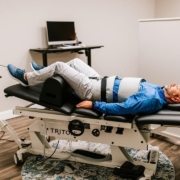The Vital Role of X-Rays in Chiropractic Care: Prioritizing Safety and Precision
Chiropractic care has gained significant popularity over the years as a natural and non-invasive approach to healthcare. With its focus on spinal manipulation and holistic healing, chiropractic treatments offer numerous benefits for individuals seeking pain relief and improved well-being. However, it is crucial to understand that a comprehensive evaluation, including X-rays, plays a fundamental role in ensuring the safety and effectiveness of chiropractic care. In this article, we will explore the importance of obtaining X-rays before embarking on chiropractic treatments.
-
Accurate Assessment of Spinal Health:
The human spine is a complex structure composed of vertebrae, discs, nerves, and supporting tissues. While a skilled chiropractor can detect misalignments and irregularities through physical examination, X-rays provide an in-depth view of the spine’s structure. X-rays reveal the precise alignment of the vertebrae, the presence of fractures, degenerative conditions, or other spinal abnormalities. This information allows chiropractors to tailor treatment plans specifically to the patient’s needs, ensuring that adjustments are both safe and effective.
-
Identifying Hidden Conditions:
X-rays offer chiropractors valuable insights into potential underlying health conditions that may not be immediately evident during a physical examination. These hidden conditions, such as tumors, infections, osteoporosis, or spinal abnormalities present at birth, can greatly impact the course of treatment. By detecting these issues early on, chiropractors can modify their approach to ensure patient safety and collaborate with other healthcare professionals as needed.
-
Personalized Treatment Planning:
Every individual’s spinal structure and health concerns are unique. By incorporating X-rays into the assessment process, chiropractors can create personalized treatment plans that address specific areas of concern. X-rays enable chiropractors to identify the source of pain or discomfort accurately, allowing for targeted adjustments and therapeutic interventions. This individualized approach ensures that patients receive the most appropriate care, maximizing the likelihood of positive outcomes.
-
Enhanced Safety Measures:
While chiropractic care is generally safe, it is not entirely risk-free. X-rays provide critical information that allows chiropractors to identify any contraindications or factors that could affect the safety of adjustments. For example, the presence of severe degeneration, fractures, or spinal instability may necessitate alternative treatment options or specific modifications to avoid further injury. By prioritizing safety through X-ray assessments, chiropractors can provide patients with the most appropriate care while minimizing potential risks.
-
Objective Progress Evaluation:
X-rays not only play a role in the initial assessment but also serve as a benchmark to evaluate the progress and effectiveness of chiropractic treatments. By comparing pre and post-treatment X-rays, chiropractors can objectively assess the changes in spinal alignment, joint mobility, and overall spinal health. This approach allows them to fine-tune treatment plans, monitor progress, and make necessary adjustments to ensure continued improvement.
Conclusion:
X-rays are an invaluable tool in chiropractic care, allowing chiropractors to perform accurate assessments, identify underlying conditions, and create personalized treatment plans. By incorporating X-rays into the evaluation process, chiropractors can ensure patient safety, deliver precise adjustments, and track progress effectively. Prioritizing the comprehensive assessment of spinal health through X-rays provides the foundation for successful chiropractic care, ultimately leading to improved well-being and long-term benefits for patients.



